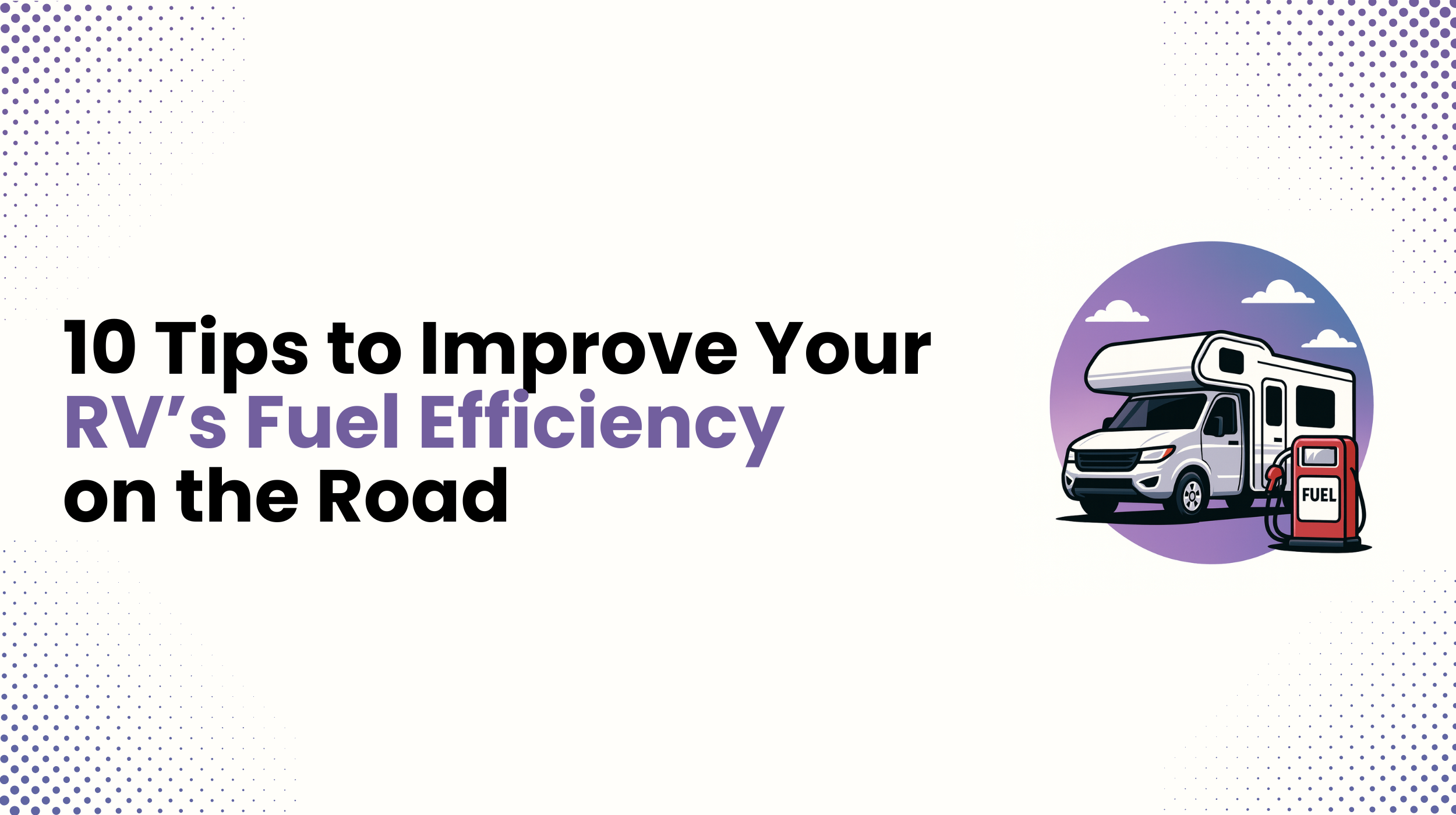TL;DR:
Fuel efficiency may sound like an oxymoron for RV travel, but small changes add up. From maintaining proper tire pressure and adopting smooth driving habits to traveling with less weight and utilizing real-time fuel monitoring apps, these 10 strategies can help cut costs, relieve stress, and make your RV trips more sustainable.
Why Improving Your RV’s Gas Mileage Matters More Than You Think
Every RVer knows the pain: you pull up to the gas pump, swipe your card, and watch the numbers climb at an alarming pace. With gas prices frequently spiking, fuel often becomes the single biggest expense on long trips, sometimes even rivaling campground fees. For many RV owners, the sticker shock of filling a 70–100-gallon tank is enough to make them reconsider their route.
Improving your gas mileage isn’t just about saving a few bucks; it’s about freedom and flexibility. A more fuel-efficient RV lets you travel farther between fill-ups, stretch your budget to visit more destinations, and reduce your environmental footprint. And while you’ll never get Prius-level MPG, there are proven ways to squeeze every last mile out of each gallon. This guide breaks down practical strategies that cover maintenance, driving, weight, and technology so you can turn “fuel efficiency” from a joke into a reality.
Part 1: Foundational Maintenance for Peak Efficiency
Before you ever leave the driveway, your RV’s condition plays a major role in how efficiently it burns fuel. A well-maintained rig doesn’t have to work as hard to perform, meaning less fuel is wasted just keeping things running. Think of this section as the pre-trip checklist that lays the groundwork for every gallon you save later.
1. Master Your Tire Pressure
Underinflated tires are one of the most common culprits behind wasted fuel. When your tires sag, they create more rolling resistance, forcing your engine to burn extra gas just to keep moving. According to the U.S. Department of Energy, proper tire inflation can improve fuel economy by up to 3%, a small number that adds up quickly on cross-country trips.
Always check your tire pressure before heading out, and ensure you measure it when the tires are cold for an accurate reading. Don’t forget seasonal adjustments: hot summer pavement can expand air pressure, while winter cold can make tires sag. Keeping a portable air compressor in your RV makes this task easy, no matter where your travels take you.
2. Commit to Regular Engine Maintenance
Your RV’s engine is the heart of your journey, and like any heart, it works best when it’s healthy. A poorly maintained engine runs less efficiently, burning more fuel to deliver the same performance. That means more trips to the pump and more money out of your pocket.
Stick to regular oil changes, and consider switching to synthetic oil, which reduces friction inside the engine. Replace air filters to maintain clean and consistent airflow, and don’t neglect spark plugs, which ensure proper combustion. According to Go RV Rentals, a full tune-up can improve gas mileage by as much as 20% which is a massive gain that makes routine maintenance a no-brainer.
3. Improve Your RV’s Aerodynamics
Let’s face it, RVs aren’t built like sports cars. They’re big, boxy, and about as aerodynamic as a brick wall. The blunt shape creates drag, which significantly increases as you drive faster. While you can’t redesign your rig, you can make small tweaks to reduce resistance.
Consider installing wind deflectors, which help channel air smoothly over your RV. Upgraded roof vent covers can minimize turbulence, and simply removing unnecessary rooftop accessories (like old cargo racks) cuts drag. Some RVers even talk about the “parachute effect” caused by the square tail of motorhomes in forums, where the flat rear end acts like a sail against the wind. Anything you can do to streamline airflow helps keep fuel waste in check.
Part 2: Smart Driving Habits to Maximize Every Gallon
Once your RV is road-ready, how you drive becomes the single biggest factor in fuel economy. Every time you stomp on the gas, speed past 70 mph, or idle for 20 minutes, you’re throwing away money. The good news? Making a few adjustments to your driving style can result in immediate benefits.
4. Find Your RV’s Sweet Spot Speed
Every RV has a speed at which it runs most efficiently, and for most models, the magic number is between 55 and 60 mph. Go faster, and aerodynamic drag ramps up dramatically. In fact, according to The Happy Camper, many RVers report up to 25% better mileage when driving at 60 mph versus 70 mph.
On flat highways, use cruise control to maintain steady speeds. However, on hilly terrain, turn it off; otherwise, your rig will guzzle fuel trying to maintain speed uphill. Think of it this way, slowing down a little may add an hour to your trip, but it could save you a tank of gas.
5. Drive Smoothly and Anticipate Traffic
“Jackrabbit” starts and hard braking isn’t just stressful; they guzzle your fuel. Every burst of sudden acceleration dumps extra fuel into the engine, and every hard brake wastes the momentum you just paid for.
Instead, practice gentle acceleration and coast whenever possible to slow down. Look ahead to anticipate stoplights, merging traffic, or slowdowns on the highway. The smoother your ride, the more your wallet will thank you.
6. Eliminate Excessive Idling
It’s tempting to leave the engine running while waiting at a rest stop or cooling the RV on a hot day, but idling is one of the most wasteful habits an RVer can have. An idling RV burns fuel without covering a single mile.
If you’ll be stopped for more than a minute, turn the engine off. At campgrounds, rely on shore power or generators for electricity rather than letting the motor run. Over time, these small changes can save gallons of fuel across an extended trip.
7. Be Strategic with Air Conditioning
Running your RV’s A/C may keep you cool, but it forces the engine to work harder, especially at highway speeds. This translates into noticeable drops in fuel efficiency.
Instead, use window vents and fans when driving at lower speeds. Pre-cool your RV while plugged into shore power before departure so you’re not relying on the engine immediately. But if you must run A/C, keep it moderate and cycle it with natural ventilation when conditions allow.
Part 3: The Surprising Impact of Weight and Load
Weight is one of the most overlooked factors in fuel efficiency. Every pound you carry requires more energy to move, and RVs, which are already heavy, are especially sensitive to overload. Smart packing and load management can make a real difference.
8. Travel Light and Declutter
Think about your RV like a backpack: the more you stuff in, the harder the journey becomes. Excess gear, unused camping supplies, and that “just in case” kayak can quickly add up to hundreds of extra pounds.
Before each trip, go through your RV and ask yourself what you really need. Create a checklist of essentials and leave the rest at home. Not only will your rig run more efficiently, but you’ll also spend less time digging through clutter on the road.
9. Manage Your Water and Fuel Tanks
One gallon of water weighs more than 8 pounds. Multiply that by a full 40–100 gallon fresh water tank, and you’re suddenly hauling the equivalent of several adults just in water weight. Add grey and black tanks, and the load grows even heavier.
Unless you’re boondocking, travel with only partial water and fill your tanks upon arrival at the campground. The same applies to fuel: if you’re taking shorter trips, a partial fill may be more efficient than dragging along a full tank. Every pound matters when you’re chasing better MPG.
Part 4: Leveraging Technology and Advanced Strategies
Today’s RVers have more tools than ever to optimize fuel efficiency. From route-planning apps to advanced monitoring systems, technology can help you make smarter decisions on the road.
10. Plan Fuel-Efficient Routes
Not all miles are created equal. A flat, open highway is far kinder to your fuel economy than a winding mountain road. Using route planning apps specifically designed for RVs can help you find the most efficient route from point A to point B.
Avoid major cities during rush hour, where stop-and-go traffic can significantly reduce your MPG. Choose RV-friendly roads where you can maintain steady speeds. Apps like RV Life, Trip Wizard, and Google Maps (with traffic overlays) are invaluable for planning smoother, more efficient routes.
11. Use Fuel Monitoring Systems
Knowledge is power, and in this case, it’s also a source of savings. Fuel monitoring apps and onboard systems let you track your real-time fuel consumption. By seeing exactly how your driving habits impact MPG, you can adjust on the fly.
Smartphone apps like GasBuddy or devices like ScanGauge give you instant data. For example, you may notice a significant drop in mileage every time you accelerate too quickly or climb steep hills. This feedback loop trains you to become a more efficient driver over time.
12. Consider Renting a Newer, More Efficient RV
Here’s an overlooked angle: if you’re not ready to buy a newer RV, renting one could be a surprisingly cost-effective option. Class B camper vans, for instance, average 18–25 MPG, compared to 6–10 MPG for many Class A and C models. That means you’ll save big on fuel for long trips.
Renting is especially smart for families who only travel a few times a year. Instead of pouring money into fueling an older, less efficient rig, you can choose the latest models with advanced aerodynamics, lighter materials, and better engines. Sites like RVshare or Outdoorsy make it easy to find rentals tailored to fuel efficiency.
Your Journey to a More Fuel-Efficient RV Adventure
Fuel efficiency in RVs may never rival compact cars, but that doesn’t mean you’re powerless. By combining smart maintenance, mindful driving, weight management, and modern tools, you can save hundreds of dollars each year and extend the life of your rig.
The next time you hit the road, start with one or two of these strategies and notice the difference. Small changes add up, and with the right approach, your RV journey can be smoother, cheaper, and kinder to the planet.
RV Fuel Efficiency FAQs
What is a realistic MPG for an RV?
Most Class A and Class C RVs average 6–10 MPG, while diesel models can travel 20–35% farther per gallon. Class B camper vans lead the pack with 18–25 MPG.
What is the most fuel-efficient speed for an RV?
The sweet spot is usually 55–60 mph. Speeds above 65 mph create significantly more aerodynamic drag, reducing efficiency. Use cruise control on flat terrain for best results.
What are 5 quick ways to improve RV fuel efficiency?
Check tire pressure before every trip
- Drive at 55–60 mph
- Travel lighter by decluttering
- Accelerate and brake gently
- Plan flatter, more direct routes
Does running the A/C really hurt mileage?
Yes. Air conditioning puts an extra load on the engine, especially at highway speeds. Use it sparingly and rely on ventilation or pre-cooling when possible.
Are diesel RVs more fuel-efficient?
Generally, yes. Diesel engines are about 20–35% more efficient than gasoline engines, offering better mileage and handling for heavy loads.

